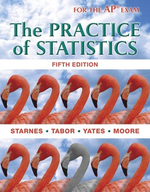Solution Found!
Section I: Multiple Choice Select the best answer for each question. Which hypotheses
Chapter 11, Problem T11.2(choose chapter or problem)
Section I: Multiple Choice Select the best answer for each question. Which hypotheses would be appropriate for performing a chi-square test? (a) The null hypothesis is that the closer students get to graduation, the less likely they are to be opposed to tuition increases. The alternative is that how close students are to graduation makes no difference in their opinion. (b) The null hypothesis is that the mean number of students who are strongly opposed is the same for each of the 4 years. The alternative is that the mean is different for at least 2 of the 4 years. (c) The null hypothesis is that the distribution of student opinion about the proposed tuition increase is the same for each of the 4 years at this university. The alternative is that the distribution is different for at least 2 of the 4 years. (d) The null hypothesis is that year in school and student opinion about the tuition increase in the sample are independent. The alternative is that these variables are dependent. (e) The null hypothesis is that there is an association between year in school and opinion about the tuition increase at this university. The alternative hypothesis is that these variables are not associated.
Questions & Answers
QUESTION:
Section I: Multiple Choice Select the best answer for each question. Which hypotheses would be appropriate for performing a chi-square test? (a) The null hypothesis is that the closer students get to graduation, the less likely they are to be opposed to tuition increases. The alternative is that how close students are to graduation makes no difference in their opinion. (b) The null hypothesis is that the mean number of students who are strongly opposed is the same for each of the 4 years. The alternative is that the mean is different for at least 2 of the 4 years. (c) The null hypothesis is that the distribution of student opinion about the proposed tuition increase is the same for each of the 4 years at this university. The alternative is that the distribution is different for at least 2 of the 4 years. (d) The null hypothesis is that year in school and student opinion about the tuition increase in the sample are independent. The alternative is that these variables are dependent. (e) The null hypothesis is that there is an association between year in school and opinion about the tuition increase at this university. The alternative hypothesis is that these variables are not associated.
ANSWER:Step 1 of 2
Given,
Proportion of strongly opposed Freshman,
Proportion of strongly opposed Sophomores,
Proportion of strongly opposed Junior,
Proportion of strongly opposed Senior,
Let’s determine which hypothesis would be appropriate for performing a chi-square test:
